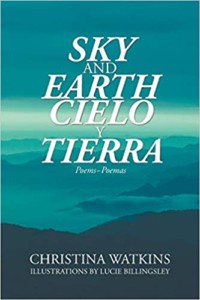Title: Sky and Earth – Cielo Y Tierra
Author: Christina Watkins
Publisher: XlibrisUS
ISBN: 978-1-7960-3080-8
Genre: Poetry
Pages: 55
Reviewed by: Allison Walker
Pacific Book Review
Sky and Earth is a fitting title for a book of poetry about the balance of natural forces, and the relationships of people living in the space between. As a poet, Christina Watkins strikes you as a gentle observer, someone tuned in to the gossamer changes of earth-nature and peoplenature. Her poems are insightful melodies following themes such as desert, dancing and family. Turn the page, and you’ll find the same poem written in Spanish. “Sky and Earth,” also titled “Cielo Y Tierra,” offers readers Watkins’ poetry written in both English and Spanish.
To translate any poetry requires a mastery of both languages, not simply proficiency or fluency. Poetry is not so much a way of writing as a marriage of words to the sounds they make when together. A poet cannot translate the words individually; she must translate the relationship between them. Watkins does a masterful job. For example, the poem “To My Mother” in its English translation rhymes; it has a winding meter and lilting melody. Its Spanish translation does not, in fact cannot rhyme. Yet, the lovely melody is preserved, and the meaning of the poem intact. In the poem a woman visits with her mother, eager and excited to be with her. The daughter seems pulled in two directions, a sense of urgency as their time together dwindles, and reverence for her mother’s slow decline. The poem in both languages must have this emotional conflict or else it cannot be the same poem. Watkins does not compromise her poems’ integrity; she marries the right words in both languages.
The emotion written so profoundly in “To My Mother” is found in most of Watkins’ book. Her second chapter, “Into the Blue,” is emotional, vivacious, yet still gentle. Her poem “Necklaces,” from the second chapter, is a tender piece about a family heirloom from her mother, made especially significant by the family coming together for the holidays. She uses the phrase “birthshaped womb message” to describe the necklace hanging around her neck after her mother bequeaths to her. It’s bold, emotive, and absolutely perfect. Another theme from Watkins’ poetry is the desert. In her poem, “Towards Phoenix,” she describes giving up one beauty for a different sort. Watkins describes the dryness of the land, the way the sparseness and largeness wins you over. She celebrates the culture of heat and desert through dance, which is a style of dance all its own.
Sky and Earth ends powerfully with God Mother the salsa dancer, hips swinging and keeping time with her sons and daughters. Like all Watkins’ poems, this piece is brief but impactful; a fitting end to a book which could also be described as such. Watkins’ poetry is emotional and exquisite, her translations thoughtfully made. There is a balance between the two poems facing each other. Watkins’ bilingualism shows the differences and the similarities between the two languages, the way they sound and appear very different, but still express the same meaning and emotion. The poet’s natural sense of rhythm, perhaps explaining her aptitude for dance, shines through in her writing as lyrical poetry. The poems have a compelling beat and expressive melody.


